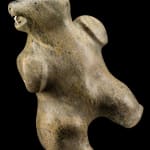-
Artworks
PAUTA SAILA, R.C.A. (1916-2009) KINNGAIT (CAPE DORSET)
Dancing Polar Bear, c. 1986-88stone and ivory, 21.75 x 18.5 x 9 in (55.2 x 47 x 22.9 cm)
signed, "ᐸᐅᑕ / ᓴᐃᓚ".
LOT 70
ESTIMATE: $30,000 — $50,000Further images
The way I have seen the movement of polar bears is the way I have carved them. Not from looking at photos but having seen them with my own eyes....The way I have seen the movement of polar bears is the way I have carved them. Not from looking at photos but having seen them with my own eyes. When polar bears are happy, they look like they are dancing…. When they don’t know people are around, they are playful. They are dangerous, but playful when they don’t see a person or dogs chasing them. White people often take photos, and when they look at the photos, they can see the action of the bear. I don’t take photos, but I do it from memory. They are not really dancing but it looks that way…. Wild animals are playful if they’re not attacked. White people think they are dancing but they are just being playful.
From an interview with the artist by Ingo Hessel, Cape Dorset, 2004
These words by the artist may clarify for some of us how Pauta thinks and feels about his favourite subjects, and how he approaches his portrayal of them. Pauta had been a keen (and unobtrusive) observer of polar since childhood and can be thought of as a true “bear whisperer.” The idea of the “dancing bear” did not spring from his imagination but came from observation and love for the animal. He likely would have preferred to call them “playful bears” because for him the term “dancing” implied a human activity. His aim was to share with us his fond memories of bears, not to anthropomorphize them.
This Dancing Bear is an exceptionally fine and quite large example. And, considering how hefty he is, this bear looks to be in top-notch physical condition. He’s not exactly svelte but his body seems well-toned and appears beautifully proportioned from every angle. The work is classic Pauta, meticulously carved and finished to perfection. The sculpture exhibits all the hallmarks of the type: powerful volumes, sensuous contours, and gorgeous curves; strong limbs pulled in to convey the sense of compressed energy; a beautifully formed head on a powerful neck; the precise detailing of the animal’s claws, eyes, nostrils and ears; the graceful parabolic shape of the mouth with its inset fangs; a perfectly balanced pose; all carved in a lovely stone. Absolutely brilliant.
References: For a similarly large, slightly later example see First Arts, Toronto, 12 July 2020, Lot 46 and its accompanying text. See also First Arts, Toronto, 1 December 2020, Lot 55. For other important examples by the artist, see Ingo Hessel, Inuit Art: An Introduction, (Douglas & McIntyre, 1998) cover and fig. 102; from 1984 in the Sarick Collection, Art Gallery of Ontario (also illus. in Gerald McMaster, ed., Inuit Modern: The Samuel and Esther Sarick Collection, (Toronto: Art Gallery of Ontario, 2010), p. 116; Bernadette Driscoll, Uumajut: Animal Imagery in Inuit, (Winnipeg: Winnipeg Art Gallery, 1985), cat. 1; TD Bank Collection (also illus. in Canadian Eskimo Arts Council, Sculpture / Inuit: Masterworks of the Canadian Arctic, (Toronto: University of Toronto Press, 1971), fig. 158); Susan Gustavison, Northern Rock: Contemporary Inuit Stone Sculpture, (Kleinburg: McMichael Canadian Art Collection, 1999) cat. 8. See also Marion Scott Gallery, Inspiration, (1996) cat. 23. See also Walker's Auctions, Ottawa, 22 November 2017, Lot 62; 13 May 2013, Lot 15; 3 May 2012, Lot 24. See Waddington's Auctions, Toronto, 30 May 2016, Lot 40; 23 April 2007, Lot 79.
Provenance
Inuit Gallery of Vancouver;
Acquired from the above by the present Private Collection, California, 1989.
Join our mailing list
* denotes required fields
We will process the personal data you have supplied in accordance with our privacy policy (available on request). You can unsubscribe or change your preferences at any time by clicking the link in our emails.










